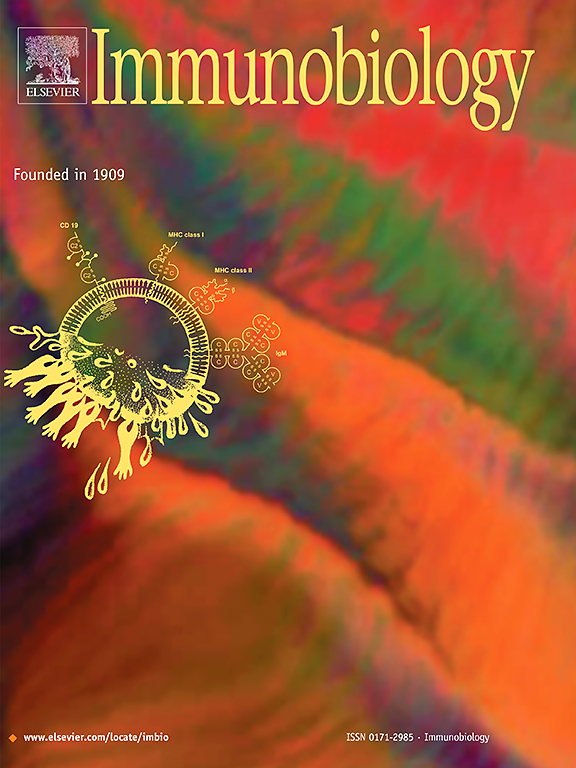Role and mechanism of METTL3 in fibrosis-associated signaling in CVB3-infected H9c2 cardiomyocytes through the lncRNA MEG3/c-MYC/SMAD2 axis
IF 2.3
4区 医学
Q3 IMMUNOLOGY
引用次数: 0
Abstract
Viral myocarditis (VMC) is an inflammatory disease of the heart muscle caused by viral infection and may lead to myocardial fibrosis. This study aims to investigate the role of METTL3 in myocardial fibrosis in VMC. METTL3 expression was intervened with in VMC cell models, followed by measurement of LDH, CK-MB, and TGF-β1. The expression of METTL3, lncRNA MEG3, c-MYC, SMAD2, Collagen I, Collagen III, and α-SMA was detected by RT-qPCR and Western blot. α-SMA expression was observed by immunofluorescence. MeRIP-qPCR was used to detect m6A levels of MEG3. RNA stability experiments were conducted to determine the residual level of MEG3. The bindings of lncRNA MEG3 to c-MYC and c-MYC to the SMAD2 promoter were analyzed. Results showed that METTL3, c-MYC, and SMAD2 were highly expressed in VMC cell models. METTL3 inhibition increased cell viability and reduced LDH, CK-MB, TGF-β1, Collagen I, Collagen III, and α-SMA. METTL3-mediated m6A modification promoted MEG3 expression, and MEG3 bound to c-MYC and enhanced SMAD2 expression. Overexpression of MEG3 or SMAD2 partially reversed the inhibitory effect of METTL3 on fibrotic-like changes of myocardial cells. In conclusion, METTL3 promotes fibrotic-like changes of myocardial cells in VMC cell models through the lncRNA MEG3/c-MYC/SMAD2 axis via m6A modification.
METTL3通过lncRNA MEG3/c-MYC/SMAD2轴在cvb3感染的H9c2心肌细胞纤维化相关信号传导中的作用和机制
病毒性心肌炎(VMC)是一种由病毒感染引起的心肌炎症性疾病,可导致心肌纤维化。本研究旨在探讨METTL3在VMC心肌纤维化中的作用。在VMC细胞模型中干预METTL3的表达,随后测量LDH、CK-MB和TGF-β1。RT-qPCR和Western blot检测METTL3、lncRNA、MEG3、c-MYC、SMAD2、Collagen I、Collagen III、α-SMA的表达。免疫荧光法观察α-SMA的表达。采用MeRIP-qPCR检测MEG3的m6A水平。通过RNA稳定性实验确定MEG3的残留水平。分析了lncRNA MEG3与c-MYC和c-MYC与SMAD2启动子的结合。结果显示,METTL3、c-MYC和SMAD2在VMC细胞模型中高表达。METTL3抑制提高了细胞活力,降低了LDH、CK-MB、TGF-β1、胶原I、胶原III和α-SMA。mettl3介导的m6A修饰促进了MEG3的表达,并且MEG3与c-MYC结合并增强了SMAD2的表达。MEG3或SMAD2的过表达部分逆转了METTL3对心肌细胞纤维化样变化的抑制作用。综上所述,METTL3通过m6A修饰lncRNA MEG3/c-MYC/SMAD2轴,促进VMC细胞模型心肌细胞的纤维化样变化。
本文章由计算机程序翻译,如有差异,请以英文原文为准。
求助全文
约1分钟内获得全文
求助全文
来源期刊

Immunobiology
医学-免疫学
CiteScore
5.00
自引率
3.60%
发文量
108
审稿时长
55 days
期刊介绍:
Immunobiology is a peer-reviewed journal that publishes highly innovative research approaches for a wide range of immunological subjects, including
• Innate Immunity,
• Adaptive Immunity,
• Complement Biology,
• Macrophage and Dendritic Cell Biology,
• Parasite Immunology,
• Tumour Immunology,
• Clinical Immunology,
• Immunogenetics,
• Immunotherapy and
• Immunopathology of infectious, allergic and autoimmune disease.
 求助内容:
求助内容: 应助结果提醒方式:
应助结果提醒方式:


